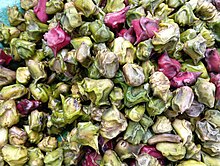
Back عكر أبو قرون Arabic عكر ابو قرون ARZ পানী শিঙৰি Assamese Һыу сәтләүеге Bashkir Вадзяны арэх Byelorussian Воден орех Bulgarian পানিফল Bengali/Bangla Castanya d'aigua Catalan Trapa CEB Kotvice (rod) Czech
| Water caltrop | |
|---|---|

| |
| Trapa natans | |
| Scientific classification | |
| Kingdom: | Plantae |
| Clade: | Tracheophytes |
| Clade: | Angiosperms |
| Clade: | Eudicots |
| Clade: | Rosids |
| Order: | Myrtales |
| Family: | Lythraceae |
| Subfamily: | Trapoideae Voigt |
| Genus: | Trapa L. |
| Type species | |
| Trapa natans L.
| |
| Species | |

The water caltrop is any of three extant species of the genus Trapa: Trapa natans, Trapa bicornis and the endangered Trapa rossica. It is also known as buffalo nut, bat nut, devil pod, ling nut, mustache nut, singhara nut or water chestnut.[1]
The species are floating annual aquatic plants, growing in slow-moving freshwater up to 5 metres (16 feet) deep, native to warm temperate parts of Eurasia and Africa. They bear ornately shaped fruits, which in the case of T. bicornis resemble the head of a bull or the silhouette of a flying bat. Each fruit contains a single very large, starchy seed. T. natans and T. bicornis have been cultivated in China and the Indian subcontinent for the edible seeds for at least 3,000 years.
- ^ "M.M.P.N.D. - Sorting Trapa names". www.plantnames.unimelb.edu.au. Retrieved 24 August 2022.
Generally there is a lot of confusion throughout the world about the vegetable called "water chestnut". The first confusion is between the European Trapa and the Chinese Eleocharis. Then people get lost within each of those genera because common names have never been properly matched to stabilised botanical names.